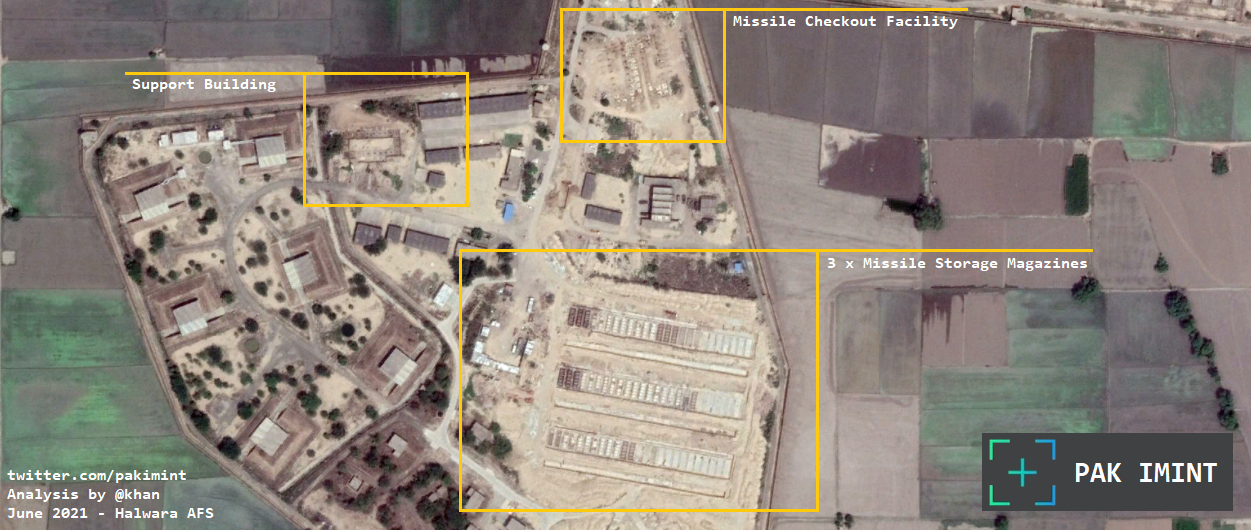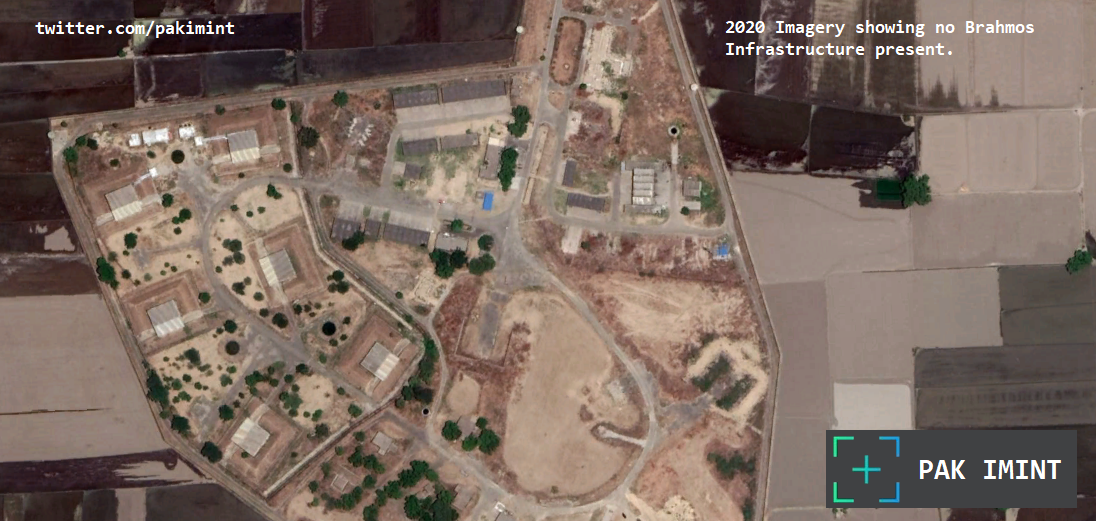HRK
PDF THINK TANK: CONSULTANT

- Joined
- Sep 24, 2010
- Messages
- 14,108
- Reaction score
- 122
- Country
- Location
Author: Zaki Khalid

A closer inspection of additional facilities situated 200 metres north of the storage area further suggest that a weapons assembly and missile checkout facility is also in the works.

BrahMos missiles are reported to have a standoff advantage with ranges of upto 300 kilometres. Thus, while being stationed at Halwara, they can cover an area of 75,000 square kilometres across the International Border.
In case of war, missiles can easily target prominent cities in Pakistan’s Punjab province including Lahore, Faisalabad, Okara, Sahiwal and Jhelum, to name a few. It can also easily take out targets in Sargodha (home to Pakistan Air Force’s Central Air Command) and Mangla, home to the Tarbela Dam.
Each BrahMos regiment comprises of 72 missiles. Therefore, the visible presence of 75 bays points to the fact that at least one regiment will be raised. This construction activity will warrant interest from Pakistan’s national security leaders.
AFS Halwara rose to prominence during the 2019 military escalation with Pakistan. Aircraft from five different bases in IAF’s Western and Central Air Commands participated in the alleged ‘cross-border strike’; these included two Su-30MKI squadrons taking off as decoys, one from Halwara.
The following year (October 2020), another noteworthy incident occurred when a BrahMos ACLM fitted on a Su-30MKI struck a target in the Bay of Bengal; the aircraft had taken off from AFS Halwara, located more than 3,000 kilometres away.
An examination of BrahMos missile tests conducted during the previous five years (2017-2021) reveals that an overwhelming majority of the tests were conducted in and around the Bay of Bengal region.
 *based on open source data held by the author
*based on open source data held by the author
Source: Click Here
The BrahMos is a supersonic cruise missile that can be launched from the land, air or sea. Variants of this missile have been developed through a joint venture between state-owned Indian and Russian defence establishments. Although India has gradually increased indigenous production of several components, its ramjet propulsion systems and seeker technology are still manufactured by Russia.
Since the inaugural test launch of the BrahMos in 2001, India has made concerted efforts to modify its original designs that are best suited to its operational interests. While some locations of its active deployments are known, examination of open source satellite imagery shared by observers at PAK-IMINT reveals that a new and dedicated storage complex for BrahMos missiles is being developed in the vicinity of Air Force Station (AFS) Halwara in Indian Punjab; the site is not more than 200 kilometres from the International Border with Pakistan.
A historical examination of available images suggests the new site was non-existent in 2020 and was likely constructed around mid 2021. The under-construction storage complex comprises of 3 linear magazines of 25 storage bays each, totalling 75 bays; at the bare minimum, the complex can store no less than 75 missiles.
Since the inaugural test launch of the BrahMos in 2001, India has made concerted efforts to modify its original designs that are best suited to its operational interests. While some locations of its active deployments are known, examination of open source satellite imagery shared by observers at PAK-IMINT reveals that a new and dedicated storage complex for BrahMos missiles is being developed in the vicinity of Air Force Station (AFS) Halwara in Indian Punjab; the site is not more than 200 kilometres from the International Border with Pakistan.
A historical examination of available images suggests the new site was non-existent in 2020 and was likely constructed around mid 2021. The under-construction storage complex comprises of 3 linear magazines of 25 storage bays each, totalling 75 bays; at the bare minimum, the complex can store no less than 75 missiles.

A closer inspection of additional facilities situated 200 metres north of the storage area further suggest that a weapons assembly and missile checkout facility is also in the works.

BrahMos missiles are reported to have a standoff advantage with ranges of upto 300 kilometres. Thus, while being stationed at Halwara, they can cover an area of 75,000 square kilometres across the International Border.
In case of war, missiles can easily target prominent cities in Pakistan’s Punjab province including Lahore, Faisalabad, Okara, Sahiwal and Jhelum, to name a few. It can also easily take out targets in Sargodha (home to Pakistan Air Force’s Central Air Command) and Mangla, home to the Tarbela Dam.
Each BrahMos regiment comprises of 72 missiles. Therefore, the visible presence of 75 bays points to the fact that at least one regiment will be raised. This construction activity will warrant interest from Pakistan’s national security leaders.
AFS Halwara rose to prominence during the 2019 military escalation with Pakistan. Aircraft from five different bases in IAF’s Western and Central Air Commands participated in the alleged ‘cross-border strike’; these included two Su-30MKI squadrons taking off as decoys, one from Halwara.
The following year (October 2020), another noteworthy incident occurred when a BrahMos ACLM fitted on a Su-30MKI struck a target in the Bay of Bengal; the aircraft had taken off from AFS Halwara, located more than 3,000 kilometres away.
An examination of BrahMos missile tests conducted during the previous five years (2017-2021) reveals that an overwhelming majority of the tests were conducted in and around the Bay of Bengal region.

It was only last month that the BrahMos ACLM received the Indian government’s nod for mass production. However, several more tests will need to take place. The July 2021 flight test was a reported failure. In view of similarities between the under-construction storage complex and similar infrastructure in Gujarat and Assam, observers at PAK-IMINT proffer that this new complex will most likely store the LACM (Land-Attack Cruise Missile).
From a military operations perspective also, it would be imprudent to construct a regiment-sized storage complex for ACLMs. As discussed earlier, a few missiles fired by Su-30MKIs based out of AFS Halwara would be sufficient to take out high-value installations across the border. Therefore, the initial assessment is that LACMs will eventually be brought for storage in this complex.
It needs to be emphasised, however, that the construction of this new storage complex in the vicinity of AFS Halwara does not, in and of itself, indicate that the IAF would be its users. There are several locations where the Indian Army deployed air defence batteries right outside IAF bases; examples include Tezpur and Missamari in Assam, where BrahMos sites of both services are located in close proximity to each other. Another example is AFS Leh, which does not reportedly have its own air defence cover and relies on an army-operated Akash battery adjacent to the base walls.
From a Pakistani standpoint, the presence of BrahMos missiles (LACM or ACLM) matters more than speculation as to which armed service will actually be the owner of the new storage complex.
From a military operations perspective also, it would be imprudent to construct a regiment-sized storage complex for ACLMs. As discussed earlier, a few missiles fired by Su-30MKIs based out of AFS Halwara would be sufficient to take out high-value installations across the border. Therefore, the initial assessment is that LACMs will eventually be brought for storage in this complex.
It needs to be emphasised, however, that the construction of this new storage complex in the vicinity of AFS Halwara does not, in and of itself, indicate that the IAF would be its users. There are several locations where the Indian Army deployed air defence batteries right outside IAF bases; examples include Tezpur and Missamari in Assam, where BrahMos sites of both services are located in close proximity to each other. Another example is AFS Leh, which does not reportedly have its own air defence cover and relies on an army-operated Akash battery adjacent to the base walls.
From a Pakistani standpoint, the presence of BrahMos missiles (LACM or ACLM) matters more than speculation as to which armed service will actually be the owner of the new storage complex.
Source: Click Here









